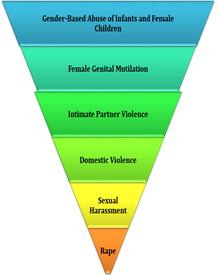Increasing Cases of Gender based Violence in India (Specials)
Context
With the recently highlighted case of the Murder, of a 27-year old girl in a live-in relationship by her partner, stunned the country and highlighted the increasing rate of Gender based violence (GBV), especially against the young women.
What is Gender based violence?
- Gender based Violence (GBV) means a harmful act directed at an individual based on their gender.
- It is rooted in gender inequality, the abuse of power and harmful norms.
- It is a serious violation of human rights and a life-threatening health and protection issue.
- This violence is not just limited to physical violence but encompasses everything from dowry deaths, honour killing, trafficking, domestic violence, intimate partner violence, sexual and emotional abuse, online abuse, child abuse, and caste-based violence among others.
|
The Numbers:
|
What are the Factors Contributing to GBV?
- Unequal status in Society
- Vulnerability of Women
- Gender Disparity
- Psychiatric Morbidity
- Sociodemographic factors
- Family factors
Impacts:
On Women:
- Threatens the autonomy and dignity
- Great economic, social, physiological, psychological and behavioural consequences
- Loss of self-believe
- Creates a social stigma for women who are Raped or sexually exploited
- Increase in instances of early marriage due to fear of parents for young girls/women of GBV.
- Illiteracy amongst women
- Impact on mental health
On India as a country:
|
Political |
Economic |
Social |
International |
|
A Politically strong and diverse country like India cannot afford such issues to rise as it highlights the policy failures by the government. |
As Women contribute to half of India's population, but are paralysed by these violence creates a loss in economic advantage of a country. |
Social norms for women where there still exists a mind-set of purity and test for women’s character makes India resolve such issues to make a welfare environment for Women to live. |
The Country like India where the Form of Women as a ‘mother’ is treated as ‘Goddess’, but else by those men treated as an object creates a question on the authenticity of culture. |
What are the loopholes in approach to address the issues?
- Victimsation of Women: Gender-based violence in India includes eliminating the institutional hurdles facing women, which leads to secondary victimization.
- Socially baised officials/decision makers: When women seek help, they are treated with hostility or negligent or discriminatory fashion by officials in charge of supporting them.
- Patriarchal Norms: The obvious progress made in the region in extending women’s formal rights has yet to lead to a practical application of those rights on a day-to-day basis, either within or outside the justice administration sphere.
Constitutional provisions to curb violence (in India):
The principle of gender equality is enshrined in the Indian Constitution in its:
- Preamble
- Fundamental Rights
- Fundamental Duties
- Directive Principles
The Constitution not only grants equality to women but also empowers the State to adopt measures of positive discrimination in favor of women for neutralizing the cumulative socio-economic, education and political disadvantages faced by them.
|
Constitutional provisions:
|
How can gender-based violence be stopped?
- Challenging social norms, creating awareness
- proactive media representation
- supporting the survivors of gender-based violence
- strengthening legislation to criminalise violence
- Society need to take accountability and comprehensively address GBV





